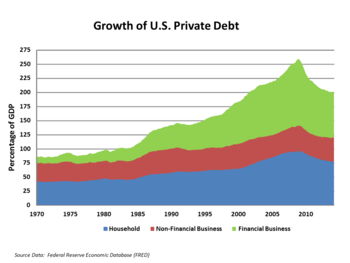Deleveraging
At the
At the
In microeconomics

While
However, precaution is not the most common reason for deleveraging. Deleveraging usually happens after a market downturn and hence is driven by the need to cover loss, which can deplete capital, build a less risky profile, or is required by nervous lenders to prevent default. In the last case, lenders lower the leverage offered by asking for a higher level of collateral and down payment. It is estimated that from 2006 to 2008, the average down payment required for a home buyer in the US increased from 5% to 25%, a decrease of leverage from 20 to 4.[1]
To deleverage, one needs to raise cash to pay debt, either from raising capital or selling assets or both. A bank, for example, can cut expenditure, sell
Deleveraging is frustrating and painful for
In macroeconomics

Deleveraging of an economy refers to the simultaneous reduction of leverage level in multiple
As in January 2012, four years after the start of the
Historical episodes of deleveraging
The McKinsey Global Institute defines a significant episode of deleveraging in an economy as one in which the ratio of total debt to GDP declines for at least three consecutive years and falls by 10 percent or more.[2] According to this definition, there have been 45 such episodes of deleveraging since 1930, including:
- The Great Depression in the United States: 1929-43
- United Kingdom: 1947-80
- Malaysia: 1998-2008
- Mexico: 1982-92
- Argentina: 2002-2008[2]
Based on this identification of deleveraging and Carmen Reinhart and Kenneth Rogoff’s definition for major episodes of financial crisis,[5] it is found that almost every major financial crisis during the period of study has been followed by a period of deleveraging.[2] After the 2008 financial crisis, economists expected deleveraging to occur globally. Instead the total debt in all nations combined increased by $57 trillion from 2007 to 2015 and government debt increased by $25 trillion. According to the McKinsey Global Institute, from 2007 to 2015, five developing nations and zero advanced ones reduced their debt-to-GDP ratio and 14 countries increased it by 50 percent or more. As of 2015, the ratio of debt to gross domestic product globally has increased by 17 percent after the crisis.[6]
Macro-deleveraging process
According to a McKinsey Global Institute report, there are four archetypes of deleveraging processes:[2]
- "Belt-tightening": this is the most common path of deleveraging for an economy. In order to increase net savings, an economy reduces spending and goes through a prolonged period of austerity.
- "High inflation": high inflation mechanically increases nominal GDP growth, thus reducing the debt to GDP ratio. E.g. Chile in 1984–91.
- "Massive default": this usually comes after a severe currency crisis. Stock of debt immediately decreases after massive private and public sector defaults.
- "Growing out of debt": if an economy experiences rapid (off-trend) real GDPgrowth, then its debt to GDP ratio will decrease naturally. E.g. US in 1938–43.
Macro-economic consequences of deleveraging
Massive deleveraging in corporate and financial sectors can have serious macro-economic consequences, such as triggering
In the
In addition to causing deflation pressure, firms and households deleveraging their
Government regulation and fiscal policy
According to the theory of
Therefore, some economists, including John Geanakoplos, strongly argue that the Federal Reserve should monitor and regulate the system-wide leverage level in the economy, limiting leverage in good times and encouraging higher levels of leverage in bad times, by extending lending facilities.[1][9] Moreover, it is more important to restrict leverage in ebullient times to prevent the crash from happening in the first place.[1]
In addition, in the face of massive private sector deleveraging,
See also
- Leverage
- Financial crisis
- Debt deflation
- Credit crunch
- Liquidity trap
- Leverage cycle
- Paradox of thrift
- Business cycle
References
- ^ a b c d [1], John Geanakoplos, The Leverage Cycle, Cowles Foundation, July 2009.
- ^ a b c d e f "Debt and deleveraging: The global credit bubble and its economic consequences". McKinsey Global Institute. January 2010. Retrieved January 14, 2016.
{{cite journal}}: Cite journal requires|journal=(help) - ^ [2], The Economist, Deleveraging: You ain't seen nothing yet, July 2011
- ^ [3] McKinsey Global Institute, Debt and deleveraging: Uneven progress on the path to growth, January 2012.
- ^ Carmen Reinhart and Kenneth Rogoff, This Time Is Different: Eight Centuries of Financial Folly, Princeton, NJ: Princeton University Press, 2009.
- ^ Dobbs, Richard; Lund, Susan; Woetzel, Jonathan; Mutafchieva, Mina (February 2015). "Debt and (not much) deleveraging". McKinsey Global Institute. Retrieved January 15, 2015.
{{cite journal}}: Cite journal requires|journal=(help) - ^ [4] "Assessing the private sector deleveraging dynamics," Quarterly Report on the Euro Area, 12(2013)1: 26-32.
- ^ [5] Cuerpo C., I. Drumond, J. Lendvai, P. Pontuch and R. Raciborski (2013), "Indebtedness, Deleveraging Dynamics and Macroeconomic Adjustment", European Economy, Economic Papers, 477 (April).
- doi:10.3386/w16337.
- ^ [6] Gauti B. Eggertsson and Paul Krugman, Debt, Deleveraging, and the Liquidity Trap: A Fisher-Minsky-Koo approach, preliminary draft, November, 2010.
